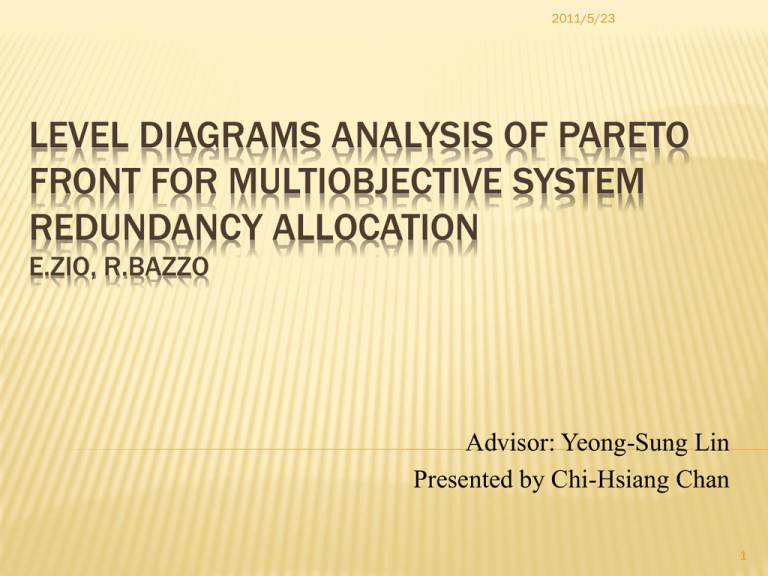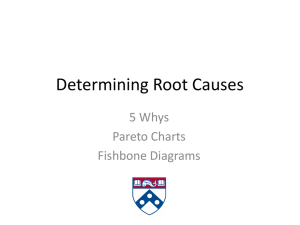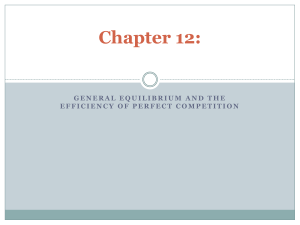20110522_Level diagr..
advertisement

2011/5/23
LEVEL DIAGRAMS ANALYSIS OF PARETO
FRONT FOR MULTIOBJECTIVE SYSTEM
REDUNDANCY ALLOCATION
E.ZIO, R.BAZZO
Advisor: Yeong-Sung Lin
Presented by Chi-Hsiang Chan
1
2011/5/23
AGENDA
Introduction
Level Diagrams representation of Pareto Fronts and Sets
Redundancy allocation in a multistate system
Visualization with the Level Diagrams
Applying preferences on the Pareto solutions
Conclusions
2
2011/5/23
AGENDA
Introduction
Level Diagrams representation of Pareto Fronts and Sets
Redundancy allocation in a multistate system
Visualization with the Level Diagrams
Applying preferences on the Pareto solutions
Conclusions
3
2011/5/23
INTRODUCTION
Multiobjective problems arise in many reliability-based and
risk-informed activities of system design, operation,
maintenance and regulation.
There is not a unique, optimal solution satisfying all
objectives, but a set of possible solutions because of the
conflicting of the several specifications.
The set of optimal solutions in the space of the decision
variables is called the Pareto Set.
The region in the space of the values of all objectives
defined by all Pareto Set points is called the Pareto Front.
4
2011/5/23
INTRODUCTION
The solution of a multiobjective optimization problem is found
in terms of a discrete approximation of the Pareto Front. DM
has to select one or more of preference within the front.
In many instances, the final decision is obtained by group
deliberation involved stakeholders and decision makers with
technical plus other values.(social and political)
There are some approaches to introduce the DM preferences
which guide the solutions selection
Priori
Posteriori
Interactively during the search
5
2011/5/23
PRIORI METHOD
The DM preferences are inserted in the mathematical
definition of the decision problem itself in a way to bias
the search for optimal solutions in priori methods.
Changing the definition of dominance like in modern
MultiObjective Evolutionary Algorithms
Weighting differently the objectives
Assigning reference values and priority levels to the objectives
Assuming a utility function describing the DM behavior and
interest in the alternative solutions
6
2011/5/23
INTERACTIVE METHOD AND POSTERIORI
METHOD
In interactive methods, the DM intervenes during the
search
Iterative trial and error
Steering the development of the search by ranking and
eliminating alternatives based on indicated preference strengths
Bounding the utility functions based on preference while
accounting for uncertainties
In a posteriori methods, the DM applies the preferences at
the end of the multiobjective optimization search, after the
optimal solutions of the Pareto Front have been found.
7
2011/5/23
VISUALIZATION OF THE PARETO FRONT
Some examples for the visualization of the Pareto Front
and Set:
Scatter diagrams
Parallel coordinates
Interactive decision maps
Level diagrams provide a geometrical visualization of the
Pareto Front and Set based on metric distance from an
ideal solution point which optimizes all objectives
simultaneously.
8
2011/5/23
INTRODUCTION
In this paper, author apply the Level diagrams analyze the
Pareto Front and Set obtained in a system redundancy
allocation problem which considered 3 conflicting
objectives: system availability to be maximized, system
cost and weight to be minimized.
The decision variables define the system redundant
configurations by taking discrete values which indicate the
numbers of components of the different types in the
configuration.
This is the first time that Level Diagrams are applied to a
problem with discrete decision variables.
9
2011/5/23
AGENDA
Introduction
Level Diagrams representation of Pareto Fronts and Sets
Redundancy allocation in a multistate system
Visualization with the Level Diagrams
Applying preferences on the Pareto solutions
Conclusions
10
2011/5/23
PARETO FRONT AND SET
The concept of Level Diagrams is illustrated, taking as
reference the relevant literature
Given the vector of decision variables
[1 ,..., p ] D
(1)
where D is the decision space, and the vector of
objective functions,
J ( ) [ J1 ( ),...J s ( )]
(2)
11
2011/5/23
PARETO FRONT AND SET
The multiobjective problem is stated in the form
min J ( )
(3)
D
Without loss of generality, a multiobjective minimization
problem has been considered in (3); a maximization
problem can be transformed into a minimization one as
follows:
max J ( ) min( J ( ))
D
D
(4)
12
2011/5/23
PARETO FRONT AND SET
Dominance and non-dominance is determined by pairwise
vector comparisons of the multiobjective values
corresponding to the pair of solutions under comparison;
specifically, 1 dominates another solution 2 if
i {1,..., s}, Ji ( 1 ) Ji ( 2 ) k {1,..., s}: J k ( 1 ) J k ( 2 )
(5)
The set θp of non-dominated solutions is called the Pareto
Set; the vector J(θ) of the values of the objective functions
in correspondence of the solutions θ of the Pareto Set θp ,
defines the Pareto Front.
13
2011/5/23
LEVEL DIAGRAMS REPRESENTATION OF PARETO
FRONTS AND SETS
It is quite difficult to let DM choose the best solution for
high dimensional problems. The task can be aided by
effectively visualizing the results of the multiobjective
optimization.
Level Diagrams represent an interesting visualization tool,
which allow classifying the Pareto solutions according to
their distance from the ideal solution.
14
2011/5/23
LEVEL DIAGRAMS REPRESENTATION OF PARETO
FRONTS AND SETS
In general, consider a multiobjective problem in which l
objectives are to be minimized and m maximized, with
s=l+m. Each objective can be normalized with respect to
its minimum or maximum values on the Pareto Front:
J i ( ) J imin
J i ( ) max
J i J imin
i 1,..., l
(6)
J imax J i ( )
J i ( ) max
i l 1,..., s
min
Ji Ji
where J i
min
(7)
min J i ( ) and J imax max J i ( )
15
2011/5/23
LEVEL DIAGRAMS REPRESENTATION OF PARETO
FRONTS AND SETS
So that now,
0 Ji ( ) 1 i 1,..., s
(8)
Where:
Ji ( ) 0 means that
the solution θ has the best value for
the ith objective.
Ji ( ) 1 means that the solution θ has the worst value for
the ith objective.
16
2011/5/23
LEVEL DIAGRAMS REPRESENTATION OF PARETO
FRONTS AND SETS
To evaluate the distance to the ideal point, a suitable norm
must be introduced. In this paper two norms are
considered:
1-norm: s
J ( ) 1 J i ( ) with 0 J ( ) 1 s
i 1
Infinite norm:
J ( ) max{J i ( )} with 0 J ( )
(9)
1
(10)
The 1-norm takes into account all the objectives; the
infinite norm considers only the worst objective.
17
2011/5/23
LEVEL DIAGRAMS REPRESENTATION OF PARETO
FRONTS AND SETS
The plot of Level Diagrams is done as follows:
Each objective and each decisional variable is plotted
separately.
The X-axis corresponds to the objective or the decsional
variable in physical units of measurement, Y-axis
corresponds to the value of norm. This means that all the
plots are synchronized with respect to the Y-axis.
18
2011/5/23
AGENDA
Introduction
Level Diagrams representation of Pareto Fronts and Sets
Redundancy allocation in a multistate system
Visualization with the Level Diagrams
Applying preferences on the Pareto solutions
Conclusions
19
2011/5/23
REDUNDANCY ALLOCATION IN A MULTISTATE
SYSTEM
Many system designs require the allocation of
redundancies to meet high reliability, but also high cost,
weight, etc.
From the system engineering view, the problem is
formulated with respect to a number of subsystems, for
each of which there are multiple component choices to be
allocated in redundancy.
This leads to the well-known redundancy allocation
problem (RAP) of which some recent formulations and
solution approaches are given.
20
2011/5/23
REDUNDANCY ALLOCATION IN A MULTISTATE
SYSTEM
A system reliability design problem with three conflicting
objectives: system availability to be maximized; system
cost and weight to be minimized.
The system is made of u=5 units(subsystems); each unit
can be provided with redundancy by selecting components
from mi types available in the market, i=1,…,5.
Each component can be 2 states: functioning at nominal
capacity or fail.
The types of components available are characterized by
their availability, nominal capacity, cost and weight in
arbitrary unit.
21
2011/5/23
Three objective functions:
Availability:
u
max J1 ( ) max Ai (i1 ,...,imi )
i 1
(11)
Cost:
u mi
min J 2 ( ) min cijij
i 1 j 1
(12)
Weight:
u mi
min J 3 ( ) min wijij
i 1 j 1
(13)
22
2011/5/23
REDUNDANCY ALLOCATION IN A MULTISTATE
SYSTEM
The problem has been solved using the MOMS-GA
algorithm. The Universal Moment Generating
Function(UMGF) was used to compute the multistate
system availability
K
A(W ) pk (Gk W )
k 1
(14)
where W is the specified demand given, K is the number of
possible output performances, pk is the probability of each
state of performance, Gk is the performance in the kth
state, and
1, x 0
( x)
0, x 0
(15)
23
2011/5/23
REDUNDANCY ALLOCATION IN A MULTISTATE
SYSTEM
As a result, the system availability depends not only on the
components individual reliability, but also on their capacity.
The Pareto Front of 118 points found is replicated in the
fig in the objective functions space.
24
2011/5/23
AGENDA
Introduction
Level Diagrams representation of Pareto Fronts and Sets
Redundancy allocation in a multistate system
Visualization with the Level Diagrams
Applying preferences on the Pareto solutions
Conclusions
25
2011/5/23
26
2011/5/23
PARETO FRONT
System design configurations of low availability are
characterized by small costs and weights and as a result,
the values of norms are large; for values of the system
availability increasing towards the optimal with respect to
all three objectives, after which the increase of cost and
weight is such that the norms increase as the point in the
Pareto Front moves away form the ideal one, optimal with
respect to all three objectives.
27
2011/5/23
PARETO FRONT
the Level Diagrams of the solutions of the Pareto Front on
the right of the minimum are represented. The objectives
have been normalized with respect to the minimum values,
to compare a range-based sensitivity coefficient defined
as
x
c
(16)
y
Availability = 0.0574
Cost = 0.5666
Weight = 0.4909
28
2011/5/23
PARETO FRONT
In the Level Diagram of system availability and 1-norm
values, the data present clusters, which shows that same
availability can be with different costs and weight.
29
2011/5/23
PARETO FRONT
The representation of the Pareto Front by means of Level
Diagrams has identified the presence of system design
configurations of similar values of availability but different
cost and weight values. The observations thereby obtained
suggest a Pareto Front reduction through the suppression
of the configurations with higher values of 1-norm among
those with similar values of one objective.
30
2011/5/23
PARETO SET
The analysis of the Pareto Set solutions in terms of the
values of the decision variables can provide the DM with
information on how system performance can be affected
by particular component choices.
In the case study, the configuration is contained in a
vector of 29 discrete decision variables; each variable
indicates the number of components of that particular
type present in the configuration.
31
2011/5/23
PARETO SET
32
2011/5/23
PARETO SET
To further analyze those configurations of high availability,
to possibly identify relations between components types
and system performance, author choose those solution on
the right of the ideal point and with ∞-norm above 0.8 of
subsystem 3
33
2011/5/23
PARETO SET
Take component θ31 for example, as increase of the
number of components θ31 leads to larger values of 1norm, high capacity but expensive. So that using less
capacitated components in subsystem 3 and other high
capacity components in other subsystem will be better
choice for less cost and maybe same availability.
Indeed, different performances of the selected highavailability configuration solutions can be attributed
mainly to the system cost because this objective (12) and
(6) presents values in a much wider range than the
normalized weight objective (13)and (6).
34
2011/5/23
PARETO SET
Dually, considering the solution on the left of the ideal
point and with ∞-norm above 0.8, we focus on low
availability configurations; the number of components of
the same type is rarely larger than one and almost only
the components with the highest capacities are present in
these configurations, in order to achieve reasonably high
availabilities keeping system weight and cost low.
35
2011/5/23
FRONT REDUCTION
A Pareto Front less crowded of solutions can be beneficial
to the DM who must analyze the different solutions and
evaluate the preferred one.
One way of proceeding to a reduction of the solutions
represented in the Front is that of focusing on the values
of one objective function and reduce to few solutions the
clusters of solutions of approximately equal availability
and different cost and weight.
36
2011/5/23
FRONT REDUCTION
To systematically perform the Pareto Front reduction, a
criterion must be established to define when two solutions
on the Level Diagrams can be considered vertically
aligned in a cluster of equal value of an objective.
To this purpose, consider a vectorJ1 of length nj containing
all the values of the availability objective of the Front
sorted in ascending order, imin be J1 of the optimal, ideal
point. norm1 be the vector containing the values of the 1norm for each solution.
37
2011/5/23
FRONT REDUCTION
Since the difference of the availability values of two
successively ranked solution, two distinct criteria are
needed to decide whether two solutions can be
considered vertically aligned in a cluster on the left and
right of the minimum value of the norm.
Then, in the vertical cluster alignment solutions with a
higher value of the 1-norm are discarded.
38
2011/5/23
FRONT REDUCTION
In the work, the solution θ(i+1) corresponding to J1(i+1)
and to norm1(i+1), belongs to a vertical cluster alignment
if the previous solution ,θ(i) is such that
3
J1 (i 1) J1 (i) 10
5
J1 (i 1) J1 (i) 10
for 1 i imin
for imin i n j
(17)
(18)
The solution θ(i) is discarded if
norm 1(i+1) < norm 1(i)
(19)
Discarded θ(i+1) if
norm 1 (i+1) > norm 1(i)
(20)
39
2011/5/23
FRONT REDUCTION
The Pareto Front is reduced from 118 to 52, with the
clusters indeed reduced to individual best points. The
reduced Pareto Front can serve as starting point for
applying preferences on the solutions, guiding the
selection to the final system configuration.
40
2011/5/23
AGENDA
Introduction
Level Diagrams representation of Pareto Fronts and Sets
Redundancy allocation in a multistate system
Visualization with the Level Diagrams
Applying preferences on the Pareto solutions
Conclusions
41
2011/5/23
APPLYING PREFERENCES ON THE PARETO
SOLUTIONS
To verify the usability of the reduced Pareto Front for
preference assignment and solution selection, it has to
investigate whether applying DM preferences on the
original Front and the reduced one produces comparable
results.
To apply preferences, on the l objective to be minimized
the solutions are classified by assigning thresholds
42
2011/5/23
APPLYING PREFERENCES ON THE PARETO
SOLUTIONS
And m objectives to be maximized, the classification is
To evaluate each solution, a scoring procedure is
established according to the “one vs. others” objective
rule: full reduction for one objective across a given region
is preferred over full reduction for all the other objective
across the next best region. i.e. (U U U) vs (D D HU)
43
2011/5/23
APPLYING PREFERENCES ON THE PARETO
SOLUTIONS
The numerical scoring procedure used to qualify the
solutions with respect to the level of preference of the
objective value they achieve:
score(0) 0
(21)
score( j ) sscore( j 1) 1 for i 1,..., m
s=3 is the number of objectives and k=6 is the number of
class
Score=(0,1,4,13,40,121)
(0.951, 10.445, 322.4)
=> 121+0+13 =134
The lowest the best
44
2011/5/23
APPLYING PREFERENCES ON THE PARETO
SOLUTIONS
To compare the results of applying preferences on the
original and reduced Pareto Front, we consider the 5 best
points (with smallest score) in the 2 cases.
Showing that the reduction process does not compromise
significantly the result of applying preferences.
45
2011/5/23
AGENDA
Introduction
Level Diagrams representation of Pareto Fronts and Sets
Redundancy allocation in a multistate system
Visualization with the Level Diagrams
Applying preferences on the Pareto solutions
Conclusions
46
2011/5/23
CONCLUSIONS
In this paper, we have applied Level Diagrams to visualize
and analyze the Pareto Front and Set resulting from the
solution of redundancy allocation for a system to be
designed for maximum availability with minimum cost and
weight.
The contribution of the work include:
Application of Level Diagrams to a reliability problem.
Implementation of the Level Diagrams in a problem with discrete
decision variables.
Sensitivity analysis of the Pareto Front whose findings can aid the
DM in choosing the best trade-off solution.
Partitioning procedure aimed at identifying relationships among
the decision values and objective functions
Procedure for Pareto Front reduction.
47
2011/5/23
THANKS FOR LISTENING
48







